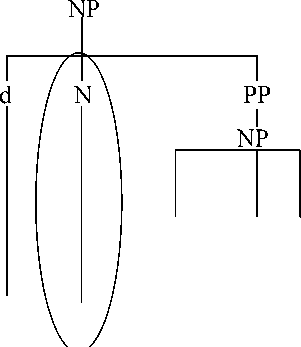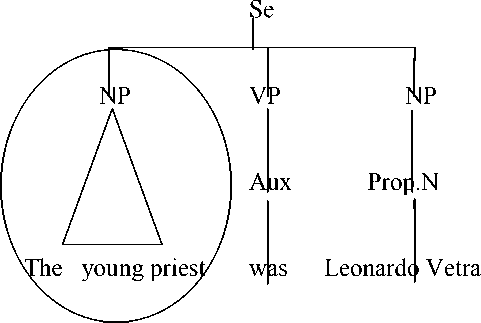English Noun Phrases With Reference To The Novel “Angels And Demons”
on
ISSN: 2302-920X
Jurnal Humanis, Fakultas Ilmu Budaya Unud
Vol 16.1 Juli 2016: 115 – 122
English Noun Phrases With Reference To The Novel “Angels And Demons”
I Putu Eka Prawijaya1*, I Gede Budiasa2, Ni Wayan Sukarini3
123
123English Department Faculty Of Letters And Cultures Udayana University
1[iputuekaprawijaya@gmail.com] 2[budiasa.igede@yahoo.com]
*
Corresponding Author
Abstrak
Makalah ini berjudul “frasa kata benda bahasa Ingris dengan kajian novel “Angels and Demons”. Makalah ini hanya memusatkan analisa kepada struktur/susunan dari frase kata benda dan fungsinya didalam kalimat. Sumber data dari makalah ini adalah frasa kata benda yang diambil dari novel yang ditulis oleh pengarang amerika yang bernama Dan Brown. Data yang terkumpul dianalisi dengan mengunakan metode descriptive qualitative metodelogy, sesuai dengan teori yang digunakan pada makalah ini. Data didapat dengan menggunakan tehnik library research. Teori yang digunakan dalam maklah ini adalah teori prase kata benda yang diusulkan oleh Leech (1982).
Stuktur dari frasa kata benda dapat digambarkan bedasarkan kepada bagian utama dari frasa kata benda itu sendiri. Pada umumnya frasa kata benda terdiri beberapa bagian yang bernama: pre-modifier, head da post-modifier. frase kata benda bahasa inngris di dalam kalimat yang dijelaskan di dalama makalah ini memiliki bebera fungsi seperti: frasa kata benda sebagai subyek, frasa kata benda sebagai obyek, sebagai complement/peelngkapan. .
Kata kunci: frasa kata benda, struktur dari frasa kata benda, fungsi dari frase dari kata benda.
Every language in the world has its own characteristics. In English there are four skills and four components, which have to be mastered. The skills, they are listening, speaking, reading, and writing and the components consist of phonology, grammar (structure), vocabulary, and fluency, which are different with our native language for example: in English grammar they have determiners before the head of noun phrase to indicate, possess, demonstrate, interrogate, numerate, and quantify the head of noun phrase, but in Indonesian we don’t have it. There are no certain directions as how grammar must be taught or learnt. The role of grammar is in part due to changing
attitude toward the language itself that make them find difficulties to remember the grammar rules
Sometimes, the use of language will be ambiguous which causes the meaning of the sentence cannot be easily understood. In this case, studying syntax is important since it studies how sentences are formed and arranged based on the grammatical rule.
Based on the explanation above, it is interesting to do a research on Noun Phrase analysis in Angels and Demons novel, because in this study it can be analyzed (noun phrase),how the novel writer (author) formed the words into noun phrase. In summary, it can be found what structures and functions are used by the novels writer in the novel Angel and Demons
Based on the background of the study, the statements of the problems are formulated as follows:
-
1) What are the structures of English Noun Phrases found in The Novels “Angels and Demons”?
-
2) What are the syntactic functions of English Noun Phrases found in The Novels “Angels and Demons”?
This study is intended to fulfill some proposed aims. The aims of study are as follows:
-
1) To give clear description of English Noun Phrase structures found in The Novels “Angels and Demons”.
-
2) To identify the syntactic functions of English Noun Phrases found in The Novels “Angels and Demons”.
This subchapter consists of three points, namely data source, data collection, data analysis. In a matter of conducting a research, an appropriate research methodology is necessary required. Three kinds research were used in this study, such as the determination of data source by choosing one specific data source Angels and Demons novels, the method of collecting data is method of gathering information in this study
were used library research method to get the data or information, and method of analyzing data is method of how we classifying the data source, in this study used qualitative method to analyze the data.
The data source of this study is a novel entitled “Angles and Demons”. The data source was taken from a book, written by American author Dan Brown and published by Pocket Books, this book is a 2000 bestselling mystery-thriller novel.“Angels and Demons” shares many stylistic literary elements with its sequel, such as conspiracies of secret societies, a single-day time frame, and the Catholic Church. Ancient history, architecture, and symbolism are also heavily referenced throughout the book.
Technique of collecting data is how to collect the data from the sources. The data was collected from Angles and Demons novel. The process of collecting data in this study was particularly concern with library research.
Library research was used in this study, because the data was taken from some literatures such as physical (theory book, the other thesis) and digital materials (ebook, information from website).
In order to collect the data of this study, there are some steps. First, reading the data source intensively then followed with scanning all noun phrases in the novel. Second, making some note taking. Here the process was done by writing down noun phrases found on the paper. And finally, the data were selected based on the classification structures and their function.
Qualitative method was used to analyze the data, since the data was classified into syntactic patterns by using the theory of tree diagram in order to find the syntactic patterns (function and structure).
The collected data was analyzed by using descriptive qualitative method classified based on the theory applied in this study. The classified data was elaborated by using the main theory and supporting theory to complete the analysis.
-
5. The analysis of English noun phrase in the novel “Angles and Demons”
5.1. The Structure of Noun Phrase
The analysis of the structure of noun phrase is based on the theory proposed by Leech, et.al. (1982) in their book entitled English Grammar for Today: A New Introduction. Three elements of noun phrase; the head, the pre modifier, and the post modifier used to elaborate every structure more clearly. The head of noun phrase may be built up with a noun, a pronoun, an adjective, an enumerator and genitive phrase. The pre-modifier may be built up with a determiner, an adjective, an enumerator, a genitive phrase and noun. The post-modifier may be built up with a prepositional phrase, a relative clause, an adverb, and an adjective.
Based on the explanation above, there is an the example of analyze:
Noun is the most common word that becomes a head of a noun phrase. When nouns act as the head, it is the core of the phrase.
Samples data:
-
1) The phone beside his bed was ringing. (Brown, 2000:2)
-
2) The torch in his hand was overkill.(Brown, 2000:39)
-
3) The freight elevator dropped like a rock.(Brown, 2000:47)
These are three brackets which explain, how noun acts as head in NP:
-
1) (MTheH phone M(beside M(his bed),
-
2) (MTheHtorch (Min M( his hand),
-
3) (MThe MfreightHelevator)

p pn N
The phone beside his bed
The tree diagram above shows that a phrase with two noun phrases, namely The phone beside his bed which the phone (noun) serve as the head. The other words in these noun phrase have a function to modify phone, the is a determiner act as premodifier, beside is a head of prepositional phrase (PP) act as postmodifier, and his bad is subordinate noun phrase act as postmodifier of prepositional phrase.
According to Leech, et.al (1982:60), there are some syntactic functions of noun phrase in the sentence or clause, a noun phrase can act as a subject (S), object (O), complement (C) and adverbial (A), in adverbial, Subordinate NPS can act as modifiers (M) in other NPS the functions above can be illustrated.
Based on the explanation above, there is an the example of analyze:
. Noun Phrase as Subject
Nouns and noun phrases first function as the subject of clauses. The subject of a sentence is one of the basic parts of a sentence which performs the action of or acts upon the verb.
Samples data:
-
1) The man's voice said when Langdon finally answered the line. (Brown, 2000:4)
-
2) "This one's a prototype of the Boeing X-33," the pilot continued, "but there are dozens of others-the ational Aero Space Plane, the Russians have Scramjet, the Brits have HOTOL. (Brown, 2000:6)
-
3) But in the 1500s, a group of men in Rome fought back against the church. (Brown, 2000:3)
-
4) The young priest was Leonardo Vetra. (Brown, 2000:32)
-
5) The red digits blinked, counting down from twenty-four hours. (Brown, 2000:43)
These are five brackets which explain the form of noun phrase as subjects in sentence:
-
1) (The man's voice),
-
2) (The Russians),
-
3) (a group of men in Rome),
-
4) (The young priest),
-
5) (The red digits blinked)

The sentence above, namely The young priest was Leonardo Vetra can be elaborated in the following:
[SNP(The young priest) P(was) ONP(Leonardo Vetra)]
In the illustration above, there are two noun phrases, The young priest and, Leonardo Vetra, but the analysis focuses on the underlined part, namely The young priest. In the sentence, the underlined part functions as a Subject. The young priest functions as a subject because it usually occurs in the beginning of the sentence. Besides, it can be seen thata subject is a word, phrase, or clause that performs the action of or an actor upon the verb.
The noun phrase (NP) used in Angles and Demons have been discussed. Based
on the overall discussion, conclusion can be drawn as follows:
First, the noun phrases may generally consist of three components, namely the pre-modification, the head, and the post-modification. The Angles and Demons contains almost all categories of noun phrase structures but, there are several noun phrases which do not have all of the elements. The head serves as the identity of noun phrase is certainly a noun (MTheH phone M(beside M(his bed), but, there are several noun phrases which contains head with different word class, likes a pronoun (HIt), an adjective (MtheHstrong), an enumerator (MtheHfirst), a genitive phrase ( M( HLangdon's) MfirstHimpression), those categories are found in Angles and Demons. From the previous chapter we can see several types of pre-modifications appear in Angles and Demons, likes a determiner (MTheHphone), a noun (Ma McomputerHprintout), an adjective (MGoodHscience Mfiction), an enumerator (MTheMfirstHhintM(of dawn), a
genitive phrase (M(HLangdon's) Hgaze), and post-modification types appears in Angles and Demons such as a prepositional phrase (MtheMdataM(on his computer screen)), and a relative clause (Ma HmanM(who kept his distance)).There is two types of noun phrase structure, that is not found, namely the structure of pre-modifier which is modified by an adverb and post-modifier which is modified by an adverb.
Second, The noun phrase in the sentences or clauses explained in this study serve several functions, such as a subject, an object, a complement, and an adverbial.
Brown, Dan. 2000. Angles and Demons.New York: Pocket Books.
Leech, et.al. 1982. English Grammar for Today.London:Macmillan Publisher Ltd
Leech, Geofrey. 1992. Introducing English Grammar. Berkeley, University of California Press.
122
Discussion and feedback